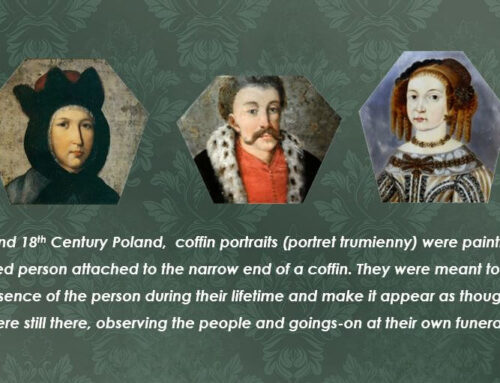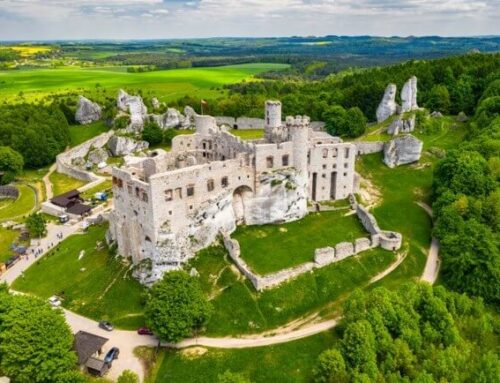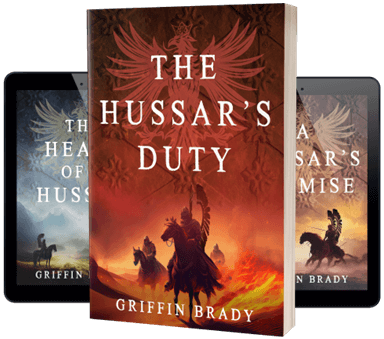Throughout the Winged Warrior Series, a band of infamous cavalrymen known as the Lisowczycy (‘Lee-soff-chit-sa’) make appearances. In The Heart of a Hussar, the fictional villain Romek Mazur is one such soldier, and he’s part of a group plundering the Muscovite village that is home to the main female lead, Oliwia, and her young brother Filip. Romek is the captain of a group of Lisowczycy and plays an important role in both this book and in the second book, A Hussar’s Promise.
In The Hussar’s Duty, fictional character Gabriel Wronski is also in charge of a band of Lisowczycy, and he, in turn, reports to his commander, the real historical figure Walenty Rogowski. Gabriel and the Lisowczycy are a major part of the story because the Lisowczycy were an integral piece in the actual Battle of Cecora, fought in 1620 in what is now Romania. In fact, they made up a third of the Commonwealth troops that battled against the Ottomans!
So who were the Lisowczycy? They were trained Polish-Lithuanian light cavalry who became a group of “irregulars,” Commonwealth mercenaries also referred to as elears, the lost men, the forlorn hope, or chorągiew elearska (company of elears). They initially formed in 1604 under Aleksander Józef Lisowski, a Lithuanian nobleman and soldier who led a konferacja (a semi-legal rebellion practiced in the Commonwealth) for unpaid wages*. When he died in the fall of 1616, the military mutineers adopted his name for their banner in his honor. Hence, they became known as the Lisowczycy, or Lisowski’s Cossacks.
In lieu of their missing pay, they turned to looting and pillaging and were highly opportunistic. While they were fearsome fighters against the Muscovites and other foes of the Crown (the Swedes, for instance), they didn’t much care if their booty came from the enemy or their own countrymen and those loyal to the Commonwealth.
The Lisowczycy were superior horsemen whose highly maneuverable units excelled at hit-and-run attacks. They were organized in the same manner as a regular hussar banner. In other words, a towarzysz (hussar, or literally, “companion”) and his poczet (retinue) would join with other towarzysze under banners led by a rotmistrz. These units were then grouped into pułks (regiments) and led by a pułkownik (colonel), who then reported to a hetman (general).
While they didn’t wear the light armor (or the wings) the hussars were known for, they carried similar weaponry—namely, sabres, pistols, arquebuses, bows, and war hammers, or horsemen’s picks.
Highly skilled, the Lisowczycy were feared and reviled by their enemies as well as their own people. But the Crown needed these fighters, and while it both exiled them and openly condemned their actions, it also looked the other way when it needed their services. Without their presence, the Habsbergs might not have prevailed at the Battle of Humenné in November 1619, where the Poles joined the Holy Roman Empire against Prince Gabriel Bethlen’s Transylvanian troops.
 They were also critical in the Battle of White Mountain in 1620 (part of the Thirty Years War), where they joined the Holy Roman Empire and the Spanish Empire in defeating the Protestants. Following the Battle of Cecora in 1620 came the Battle of Chocim in 1621, in which they once again were a crucial piece of the Commonwealth army. That battle culminated in a peace treaty, finally bringing the Moldavian Magnate Wars to an end.
They were also critical in the Battle of White Mountain in 1620 (part of the Thirty Years War), where they joined the Holy Roman Empire and the Spanish Empire in defeating the Protestants. Following the Battle of Cecora in 1620 came the Battle of Chocim in 1621, in which they once again were a crucial piece of the Commonwealth army. That battle culminated in a peace treaty, finally bringing the Moldavian Magnate Wars to an end.
Eventually, their widespread atrocities became too large a festering thorn in the Commonwealth’s side. They were consequently hunted down and executed. In 1636, the Sejm (the lower house of Polish Parliament) officially disbanded them, though they lived on in imaginations and, like so many ferocious warriors of the past, became somewhat romanticized.
*According to the Kadrinazi Blog (Despite Destruction, Misery and Privations), they were paid at the same rate as the regular army, though their wages were much delayed (also not unlike the regulars).









Leave A Comment